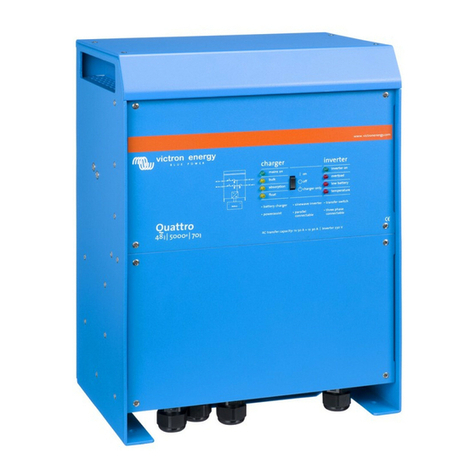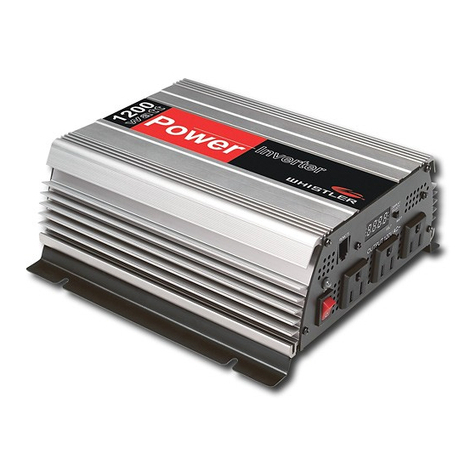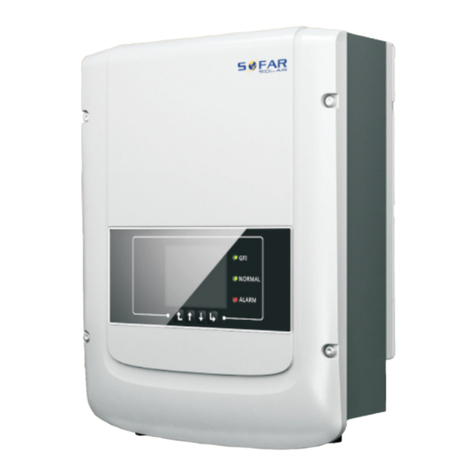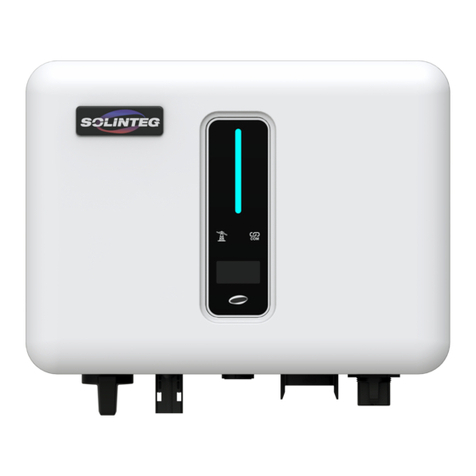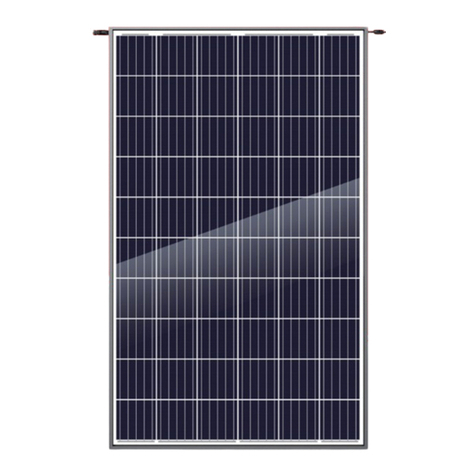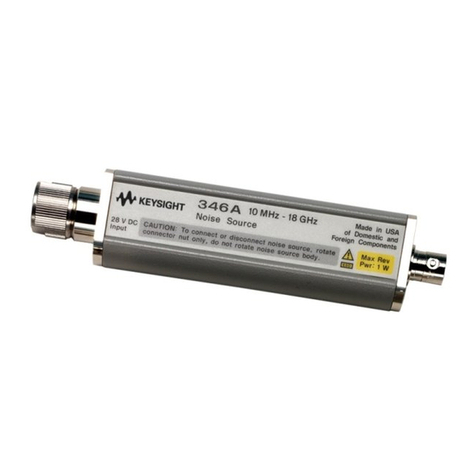SKANBATT P-300 Instruction Manual

POWER INVERTER
User manual
1.
Low voltage input model adopt original imported IR MOS tube. The current is 5.5 times of rated current.
2.
Its low voltage input connection adopt high frequency low resistivity electrolytic capacitor. However ordinary capacitor
will explode if the temperature become very high.
3.
Every transformer has independent fuse protection. If there is a MOS tube break down, then the fuse will break fast. So
that will not effect other MOS tube to break.
4.
All the protection signal adopt monolithic processing. Circuit is simple and stable.
5.
Input and output are isolated to ensure the operation stability.
6.
Output circuit adopt convertible circuit. The SPWM signal produced by Single Chip Microcomputer drive the A3120
optical coupler. Then the optical coupler isolated drive the output through IGBT tube. Adopt negative pressure to cut off
IGBT to eliminate Miller effect, so the output is more steady.
7.
The whole design adopt patch technology. The circuit is simple and steady.
8.
Allow ON/OFF button controlled by remote control switch;
9.
LED indicate and alarm notice the protection function start.
Congratulations and thank you for purchasing ours Power Inverter.
Carefully read, understand and comply with all instructions before use.
Edition:19/13 Revised:19/08

CONTENTS
Introduction--------------------------------------------------------------
Safety---------------------------------------------------------------------
Auto protect functions ------------------------------------------------
Product characteristic ------------------------------------------------
Installation Guidelines-------------------------------------------------
Instruction ofoperation-----------------------------------------------
Troubleshooting--------------------------------------------------------
Specifications-----------------------------------------------------------
Inverter operating equipments referencechart-----------------
1.
Introduction
Thank you for purchasing the Power Inverter. The inverter is a compact and highly portable power inverter, the
leader in the field of high frequency inverter design. From the 12V/24V/36V/48V DC outlet in your vehicle or boat,
or directly from a dedicated 12V/24V/36V/48V DC battery, the inverter will efficiently and reliably power a wide
variety of household AC products, such as TVs, computers, VCRs, and many more. The inverter is designed to
provide years of trouble-free operation and includes automatic safety monitoring circuitry to protect the inverter,
and your battery, from inadvertent overload conditions.
Read this guide before installing or using the inverter and save it for future reference.
2.
Safety
Incorrect installation or misuse of the inverter may result in danger to the user or hazardous conditions. We urge
you to pay special attention to all CAUTION and warning statements. Caution statements identify conditions that
may result in personal injury or loss of life.
WARNING! Shock hazard. Keep away from children.
●
The inverter generates the same potentially lethal AC power as a normal household wall outlet. Treat it
with the same respect that you would any ACoutlet.
●
Do not insert foreign objects into the inverter's AC outlets, fan or ventopenings.
●
Do not expose the inverter to water, rain, snow or spray.
●
Do not under any circumstances, connect the inverter to utility power AC distributionwiring.
WARNING! Heated surface.
The inverter’s housing may become uncomfortably warm, reaching 140℉(60℃) under extended high
power operation. Ensure at least 2 inches (5 cm) of air space is maintained on all sides of the inverter.
During operation, keep away from materials that may be affected by high temperatures.
WARNING! Explosion hazard.
●
Do not use the inverter in the presence of flammable fumes or gases, such as in the bilge of a gasoline
powered boat, or near propane tanks. Do not use the inverter in an enclosure containing automotive-
type, lead-acid batteries. These batteries, like sealed batteries, vent explosive hydrogen gas, which can
be ignited by sparks from electrical connections.
●
When working on electrical equipment always ensure someone is nearby to help you in anemergency.
CAUTION!
●
Do not connect live AC power to the inverter’s AC outlets. The inverter will be damaged even if it is
switched off.
●
Do not expose the inverter to temperatures exceeding 104℉(40℃)
CAUTION!
● Connect inverter only to batteries with a 12V/24V/36V/48V DC nominal output. Wrong DC input will not
supply enough voltage or damage the inverter.
CAUTION! Do not use the inverter with the following equipment:
●
Small battery operated products such as rechargeable flashlights, some rechargeable shavers, and
night-lights that are plugged directly into an AC receptacle torecharge.
●
Certain battery chargers for battery pack used in hand powered tools. These chargers will have warning
labels stating that dangerous voltages are present at the charger’s battery terminals.
●
Connect inverter only to batteries with a 12V/24V/48V DC nominal output. A battery with 6V/12V/24V
nominal output will not supply enough voltage and a battery with 24V/48V/96V a nominal output will
damage the inverter.
CAUTION! Any internal adjustment on the inverter is prohibit!
3.
Auto protect functions
These advanced safety features are built into the inverter. Electronic overload protection with automatic shutdown.
●
Built-in internal backup DC fuse provides added safety.
●
Low battery voltage warning followed by automatic shutdown.
●
High input voltage protection with automaticshutdown.
●
Over temperature protection with automatic shutdown.
●
Output short circuit protection.
4.
Product characteristic
Please make sure you have known the basic characteristic of this power inverter before use.

1--- AC output sockets :can choose the socket type as you like . Any combination of 110V AC or 220V AC
products with a total continuous power consumption of the continuous power or less may be plugged in.
2---USB port :DC 5V,500mA
3---AC switch: tum on/off the AC output power. Enables output AC power at the AC outlets when switched ON.
4---Green LED light :indicates AC power is present at the AC outlets and the inverter is operating normally.
5---Red LED light :indicates inverter shutdown caused by low or high voltage, overload or excessive
temperature.
6---Thermovent :withsmall fan built inside, can lower the temperature of inverter. Should keep it clean during the
inverter working.
7---Positive terminal: connect with the positive (+) side of the battery.
8---Negative terminal: connect with the negative (-) side of the battery.
9---Ground terminal: connect to the ground, counseling electrical power.
10---Fuse: can protect the inverter when the current is too excessive.
Output wave form:
The inverter is capable of continuously powering most 100-120V/200-240V AC products that use the rated
continuous output power or less. Its AC output waveform, called
Pure sine wave □
Modified sine wave □
It is designed to function as the sine wave shape of utility power.
5.
Installation Guidelines
Selecting a suitable location
For safe and optimum performance, Install the inverter in a location that is....
●
Dry. Do not expose to water drip or spray.
●
Cool. Better to be used in ambient temperatures between 32℉(0℃) and 104℉(40℃). Keep away from
furnace heating vents or other heat producing equipment.
●
Well ventilated. Allow at least 2 inches (5cm) clearance above and on all sides of the unit for propercooling.
●
Safe. Do not install inverter in a compartment with non-sealed batteries or flammable liquids, such as gasoline,
or explosive vapors.
●
Clean and free of dust and dirt. This is especially important if the inverter is used in a work environment.
Due to limitations in the common 12V/24V/36V/48V outlet in a vehicle or boat, the inverter should only be used to
supply AC power which is below the inverter ratedpower.
1.
Before connecting your new inverter, you should make a visual inspection to ensure no visible damage has
been caused by shipping. Then make sure the Main Power Switch of the inverter is Off(O).
CAUTION! A reverse polarity connection (positive to negative) may damage the inverter. Damage
caused by a reverse polarity connection is not covered under warranty.
2.
Tighten the nut on each DC terminal by hand until it is snug. Do not over tighten.
3.
Insert the plug of this cable into the 12V/24V/36V/48V DC outlet and switch the unit ON. See Section 4 if the
inverter does not operate properly after being connected*
4.
When the inverter is not in use, unplug it from the 12V/24V/36V/48V DC outlet to prevent slight discharge of the
battery.
6. Instruction of operation
Using the DC Cable Clips or Direct Connect Cables
By directly connecting the inverter to a 12V/24V/48V DC battery with the DC Cable-Chips, you can operate
products with power requirements up to the rated continuous output power.
1.
All inverters may be turned ON ('-') or OFF("O") using the main power switch,
2.
The fan is thermally controlled and will only turn on asneeded.
3.
Now that you have confirmed the inverter is operating as expected, it is time to connect your equipment to the
inverter.
4.
You are now ready to enjoy the use of your new inverter and may turn it on.
Using the Inverter
The power, or 'wattage', rating of AC products is average power they use. When many AC products are first
switched on, they initially consume more power than their power rating.
For loading such as motor rectifier, there is a surge current when starting. Please note the starting current can’t
exceed the maximum rated current. (The starting current of motor may be 7-12 times the rated current.)
CAUTION! Modified sine wave inverter can't take above mentioned load.
It is normal that the output voltage drops when a heavy load is present. You must take action in case of
below conditions.
When the battery DC voltage is reduced below 11V/21V/31V/42V.
Solution:
●
increase the battery capacity.
●
reduce the load on inverter.
When output AC voltage drops below acceptable levels (106V/210V AC).
Solution:
●
increase the battery capacity.
●
reduce the load.

Although the inverter can supply momentary surge power, occasionally some products rated less than the rated
continuous output power may exceed its surge capabilities and trigger its safety overload shut down feature. If
this problem occurs when attempting to operate several AC products at the same time, try first switching on the
inverter with all AC products switched off. Then one by one switch each on, starting with the high surge product
first.
Inverter Operation
1.
When properly connected to a 12V/24V/36V/48V DC outlet or battery, turning the ON/OFF("—"/"O”)switch
ON("—"), will illuminate the green POWER light, and deliverAC power to the Outlets.
2.
Plug the AC product(s) you wish to operate into the AC outlet(s) and switch them on, one at a time.
3.
As the battery is used up, battery voltage begins to fall. When the inverter senses that the voltage at its DC
input has dropped to 10.5~11V/21~22V/31~32V/41~42V, an audible alarm sounds. This allows time for
computers or other sensitive devices to be shut down.
4.
If the audible alarm is ignored the inverter will automatically shut down when the battery voltage drops to
10~11V/20~21V/30~31V/40~41V. This prevents battery damage from excessive discharge. After auto shut
down, the red FAULT light illuminates.
IMPORTANT: Vehicle batteries are designed to provide brief periods of very high current needed for
engine starting. They are not intended for constant deep discharge. Regularly operating the inverter
from a vehicle battery until the low voltage alarm sounds will shorten the life of the battery. Consider
connecting the inverter to a separate deep discharge type battery if you will be frequently running
electrical products for extended period of time.
5.
If an AC product rated higher than the rated continuous power (or which draws excessive surge power) is
connected, the inverter will shut down. The red FAULT light will turn on.
6.
If the inverter exceeds a safe operating temperature, due to insufficient ventilation or a high temperature
environment, it will automatically shut down. The red FAULTlight will turn on and the audio warning will sound.
7.
Should a defective battery charging system causes the battery voltage to rise to dangerously high levels, the
inverter automatically shuts down.
CAUTION! Although the inverter incorporates protection against over-voltage, it may still be damaged if
the input voltage exceeds 16V/31V/46V/62V DC.
8.
The cooling fan is designed to operate only when the temperature is higher than104℉(40℃).
9.
In the event of an overload, low battery voltage or overheating, the inverter will automatically shut down (See
Section 4 Troubleshooting).
10.
The inverter will need to be manually reset when shut down by overload.
Battery Operating Time
Operating time will vary depending on the charge level of the battery, its capacity and the power level drawn by
the particular AC load.
When using a vehicle as a power source, it is strongly recommended to start the vehicle every hour or two to
charge the battery before its capacity drops too low. The inverter can operate while the engine is running, but the
normal voltage drop that occurs during starting may trigger the inverter’s low voltage shutdown feature.
Because the inverter draws less than the no load current draw with the ON/OFF ("—"/"O")
switchin ON ("—”)positionand with no AC products connected, it has minimal impact on battery operating times.
Interference with Electronic Equipment
Generally, most AC products operate with the inverter just as they would with household AC power. Below is
information concerning two possible exceptions.
Buzzing Sound in Audio Systems andRadios
-some inexpensive stereo systems, boom boxes, and AM-FM radios have inadequate internal power supply
filtering and buzz slightly when powered by the inverter. Generally, the only solution is audio product with a higher
quality filter.
Television Interference
-The inverter is shielded to minimize its interference with TV signals. However, with weak TV signals interference
may be visible in the form of lines scrolling across the screen. The following should minimize or eliminate the
problem:
●
Use an extension cord to increase the distance between the inverter and the TV, antenna andcables.
●
Adjust the orientation of the inverter, television, antenna and cables. Maximize TV signal strength by using a
better antenna and use shielded antenna cable where possible.
●
Try a different TV. Different models of televisions vary considerably in
●
Their susceptibility to interference.
Frequently Asked Question about Power Inverter
Q: Are there any disadvantages of using “modified sine wave” inverter?
"Square Modified Sine Wave" inverters will run most tools and appliances without any problem and are the most
common type of inverter on the market.
Below are the advantages of "Pure Sine Wave" (also called True Sine Wave) inverters over modified sine wave
inverters:
1.
Reduces audible and electrical noise in fans, audio amplifiers, TV and some sensitive audiosystem.
2.
Inductive loads like microwave ovens and motors might run faster, quieter and cooler.
3.
The following devices that might not work with modified sine wave inverters:
●
Some battery chargers for cordless tools
●
Some new furnaces and pellet stoves with microprocessor control
●
Sensitive electrical or electronic items such as certain medical equipment
Troubleshooting
Possible Cause
Suggested Remedy
PROBLEM: AC product will not operate, no inverter lights are ON.
Battery is defective.
Check battery and replace if required.
Inverter has been connected with reverse DC
input polarity.
Check connection to battery. Probable inverter damage has
occurred., Have unit repaired (not covered by warranty).
Loose cable connections
Check cables and connections.
Tighten as required.
PROBLEM: Inverter will run some small loads, but not larger ones.
Voltage drop across DC cables.
Reduce the cable and use bolder one
PROBLEM: Measured inverter output is too low.
Standard average-reading AC voltmeter used
to measure output voltage, resulting in an
apparent reading below 100V or 200V AC.
Inverter's 'pure sine wave' Output Requires 'true RMS' voltmeter,
such as Fluke 87 series multimeter, for accurate measurement.
Battery voltage is too low.
Recharge battery.
PROBLEM: Alarm is sounding.
Low voltage shutdown or thermal shutdown
has occurred.
Shorten cables or use heavier cables.
Recharge battery. Allow unit to cool. Improve air circulation around
unit. Locate unit to a cooler environment.
Reduce load if continuous operation is Required.
PROBLEM: Battery run time is less than expected.
AC product power consumption is higher than
rated.
Use a larger battery to make up for increased power requirement.
Battery is old or defective.
Replace battery.
Battery is not being properly charged.
Many simple chargers are unable to charge a battery fully. Replace
charger with better model such as a TRUECHARGE smart charger.
Use shorter/heavier DC cables.
PROBLEM: AC product will not operate, red FAULT light ON.
AC product(s) connected are rated at more
than the rated continuous output power. over
load shutdown has occurred.
Use product with a power rating less than the rated continuous
output power;
AC Product is rated less than the rated
continuous output power; high staring surge
has caused overload shutdown.
Product exceeds inverter's surge capability. Use a product with
starting surge power within the inverter's capability.
Battery is discharged (alarm is sounding).
Recharge battery.
Inverter has overheated due to poorventilation
and has caused over temperatureshutdown.
Switch inverter OFF and allow to cool for 15 minutes. Clear
blocked fan or remove objects covering unit. Locate unit to a cooler
environment. Reduce load if continuous operation is required,
restart.

9. Inverter operating equipments reference chart
8. Specifications
DC input voltage range
11~15.5V/22~31V/33~46V/44~61VDC
AC output voltage (nominal)
100~120V/200~240VAC
AC output frequency(Pure sine wave)
50/60 ±0.5Hz
AC output frequency(Modifie4 sine wave)
50/60 ±2Hz
Ambient operating temperature range
-15℃~50℃
Low battery alarm trigger range (nominal)
10.5~11.5V/21~23V/31~33V/41~43VDC
Low battery shut down range (nominal)
9.5~10.5V /19~21V/29~31V /39~41VDC
High battery shut down range (nominal)
15.5V /31V /46V /61VDC
Pure Sine Wave Inverter
CP-Continuous Power
SP=Surge Power
THD=Total Harmonic Distortion
NL=No load Current Draw
Specifications subject to change without notice
Item
CP
SP
Efficiency
THD
NL
P-300
300W
600W
90%
≤3%
<0.4A(12V),<0.2A(24V) ,<0.1A(48V)
P-500
500W
1000W
90%
≤3%
<0.5A(12V),<0.3A(24V) ,<0.2A(48V)
P-600
600W
1200W
90%
≤3%
<0.5A(12V),<0.3A(24V) ,<0.2A(48V)
P-1000
1000W
2000W
90%
≤3%
<0.8A(12V),<0.4A(24V) ,<0.2A(48V)
P-1500
1500W
3000W
90%
≤3%
<1.0A(12V),<0.5A(24V) ,<0.3A(48V)
P-2000
2000W
4000W
90%
≤3%
<1.2A(12V),<0.6A(24V) ,<0.3A(48V)
P-2500
2500W
5000W
90%
≤3%
<1.5A(12V),<0.8A(24V),<0.4A(48V)
P-3000
3000W
6000W
90%
≤3%
<1.5A(12V),<0.8A(24V),<0.4A(48V)
Modified Sine Wave Inverter
Item
CP
SP
Efficiency
NL
M-150
150W
300W
90%
<0.3A(12V),<0.2A(24V) ,<0.1A(48V)
M-300
300W
600W
90%
<0.4A(12V),<0.2A(24V) ,<0.1A(48V)
M-500
500W
1000W
90%
<0.5A(12V),<0.3A(24V) ,<0.2A(48V)
M-600
600W
1200W
90%
<0.6A(12V),<0.3A(24V) ,<0.2A(48V)
M-800
800W
1600W
90%
<0.8A(12V),<0.4A(24V) ,<0.2A(48V)
M-1000
1000W
2000W
90%
<0.8A(12V),<0.4A(24V) ,<0.2A(48V)
M-1200
1200W
2400W
90%
<0.8A(12V),<0.4A(24V) ,<0.2A(48V)
M-1500
1500W
3000W
90%
<1A (12V), <0.5A(24V), <0.3A(48V)
M-2000
2000W
4000W
90%
<1.5A(12V),<0.8A(24V),<0.4A(48V)
M-2500
2500W
5000W
90%
<1.5A(12V),<0.8A(24V),<0.4A(48V)
M-3000
3000W
6000W
90%
<1.8A(12V),<0.9A(24V),<0.5 A(48V)
Input voltage is greater than 16V/31V/46V/61V
DC.
Verify charging system is properly regulated and battery is
12V/24V/36V/48V DC nominal.
With display inverter, display content meaning
Displays content in normal state
Rolling display of input voltage, output frequency and operating
temperature.
Four red LED indicators display the load percentage
respectively:25%、50%、75%、100%。
UVL
Input voltage Low voltage protection
OLP
Output overload protection or output short circuit protection
OTP
Over temperature protection
OVP
Input voltage over-voltage protection
Audio / Video Equipment
Power
150W
300W
600W
1000W
1500W
2000W
12 Inch colour TV
16W
✔
✔
✔
✔
✔
✔
Games console
20W
✔
✔
✔
✔
✔
✔
Satellite TV receiver
30W
✔
✔
✔
✔
✔
✔
Sharp HiFi stereo 4-head VCR
40W
✔
✔
✔
✔
✔
✔
Kenwood CD changer / mini system
60W
✔
✔
✔
✔
✔
✔
19 Inch colour TV
80W
✔
✔
✔
✔
✔
✔
Quasar 20 Inch TV/VCR combo
110W
✔
✔
✔
✔
✔
✔
27 Inch colour TV
170W
✔
✔
✔
✔
✔
RCA 240W RMS stereo amplifier
250W
✔
✔
✔
✔
✔
Home theatre system
500W
✔
✔
✔
✔
Domestic Appliance
Power
150W
300W
600W
1000W
1500W
2000W
Singer sewing machine
99W
✔
✔
✔
✔
✔
✔
mes halogen worklight
100W
✔
✔
✔
✔
✔
✔
Clothers washer (horizontal)
250W
✔
✔
✔
✔
✔
Blender
350W
✔
✔
✔
✔
Electric blanket
400W
✔
✔
✔
✔
Dishwasher - cool dry
700W
✔
✔
✔
Hair curler
750W
✔
✔
✔
Microwave - 750W
900W
✔
✔
✔
Vacuum cleaner
900W
✔
✔
✔
Coffeemaker
1200W
✔
✔
Dishwasher - hot dry
1450W
✔
✔
Trash compactor
1500W
✔
Large Hob
2000W
✔
Home Office
Power
150W
300W
600W
1000W
1500W
2000W
Fax machine - standby
5W
✔
✔
✔
✔
✔
✔
Inkjet printer
35W
✔
✔
✔
✔
✔
✔
Toshiba satellite laptop computer
40W
✔
✔
✔
✔
✔
✔
IBM thinkpad
42W
✔
✔
✔
✔
✔
✔
Fax machine - printing
50W
✔
✔
✔
✔
✔
✔
Desktop computer
55W
✔
✔
✔
✔
✔
✔
17 Inch colour monitor
100W
✔
✔
✔
✔
✔
✔
Bell fax, auto feed with cutter
165W
✔
✔
✔
✔
✔
Laser printer
900W
✔
✔
✔
Lighting
Power
150W
300W
600W
1000W
1500W
2000W
100W incandescent light
100W
✔
✔
✔
✔
✔
✔
Regent twin work light
900W
✔
✔
✔
Regent contractor grade work light
1066W
✔
✔
Power tools
Power
150W
300W
600W
1000W
1500W
2000W
Stanley glue gun
20W
✔
✔
✔
✔
✔
✔
Black & decker buffer
77W
✔
✔
✔
✔
✔
✔
Dremel moto tool
99W
✔
✔
✔
✔
✔
✔
Craftsman rotary power tool
126W
✔
✔
✔
✔
✔
✔
Weller soldering gun
132W
✔
✔
✔
✔
✔
✔
Makita Fnishing sander
176W
✔
✔
✔
✔
✔
Iron smith 5 Inch bench grinder
180W
✔
✔
✔
✔
✔
Craftsman industrial sander
220W
✔
✔
✔
✔
✔

Makita 4 Inch disc grinder
529W
✔
✔
✔
✔
Jepson 1/2 Inch reversible drill
620W
✔
✔
✔
✔
Dewalt H.D. reciprocating saw
720W
✔
✔
✔
✔
Grinder, l/2hp
1080W
✔
✔
McCulloch 14 Inch chain saw
1200W
✔
✔
Worm drive 7 1/4 Inch saw
1800W
✔
Table saw 10 Inch
1800W
✔
All manufactures names used are trademarks of their original owners and are recorded here only for information
1.
Definition Warranty commitment WARRANTY TABLE
“three guarantees” refer to return, replacement, repair. Customer buy the inverter from us, our company promise
to repair free during the guaranteed period . Out guarantee period, our repair service will based on customers'
expense for the repair service charge and material costs as stipulated.
2.
Repair certificate
When there is something wrong with the inverter during the three guarantees period, customers should show the
purchase invoice and repair certificate to manage the repair, the code on inverter should be the same with the
code on repair certificate, free repair service is not available if they are not accordant or lack of any one.
3.
Three guarantees limited period
3.1.
If there is any function defect within 30 days from the inverter out of the our warehouse date on, distributors
can choose return, replace or repair.
3.2.
If there is any function defect within 90 days from the inverter out of the our warehouse date on, distributors
can choose replace or repair.
3.3.
within 12 months from the inverter out of the our warehouse date on, free repair service is available for
distributors.
4.
The start date of guarantee for the replacement subject to the replace date.
5.
Those conditions do not belong to the three guarantees
(1)
Damage caused by taking apart and repairing privately without any permission of our company.
(2)
Without any quality problem.
(3)
Changed or mismatch product code.
(4)
Damage cause by improper store, installation or maintenance.
(5)
Damage caused by irresistible force .
(6)
Gift
All the stipulations are subject to our final explanation.
Product information:
Model NO.: Serial NO.:
Voltage: 12V□24V□36V□48V□
Output wave form : Pure sine wave □Modifled sine wave □
What is the main reason for selecting this product? ( select only one)
Performance □
Recommendation□
Warranty □
Price □
Features □
Size □
Appearance □
Other □
Please mail this card to your power inverter dealer/distributor.
Owner information
Dealer information
Owner name:
Owner name:
Company:
Company:
Address:
Address:
City: State: Zip code:
City: State: Zip code:
Country: Phone:
Country: Phone:
Email:
Email:
This manual suits for next models
18
Table of contents
Popular Inverter manuals by other brands
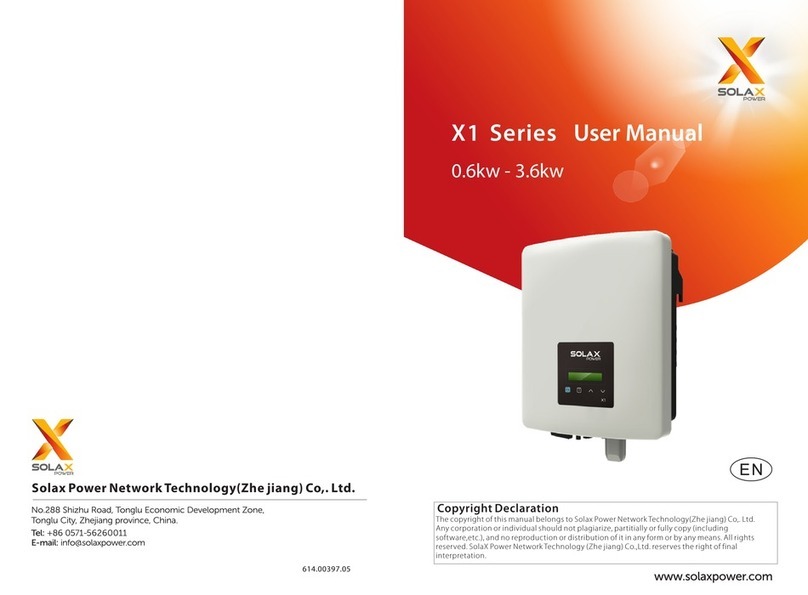
SolaX Power
SolaX Power X1-0.6-S user manual

Studer
Studer variostring 70 quick guide

TECO-Westinghouse Motor
TECO-Westinghouse Motor EV INVERTER Series operating manual
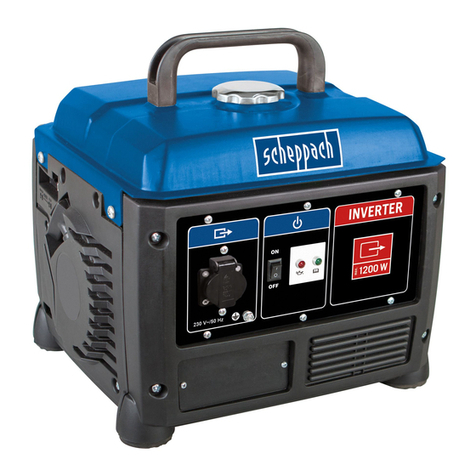
Scheppach
Scheppach SG1200 Translation from the original instruction manual

INVT
INVT XG25-40KTR user manual
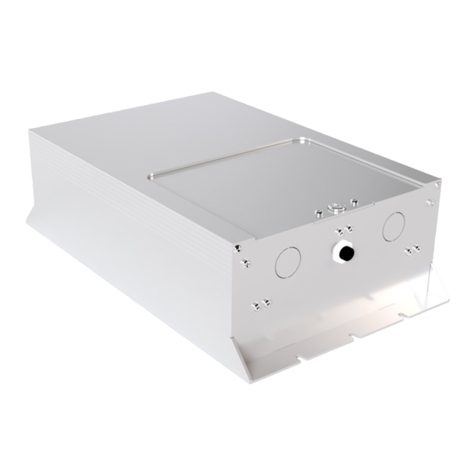
MYERS
MYERS LVM-125 installation manual

Esoteric
Esoteric Esoteric G-03X owner's manual
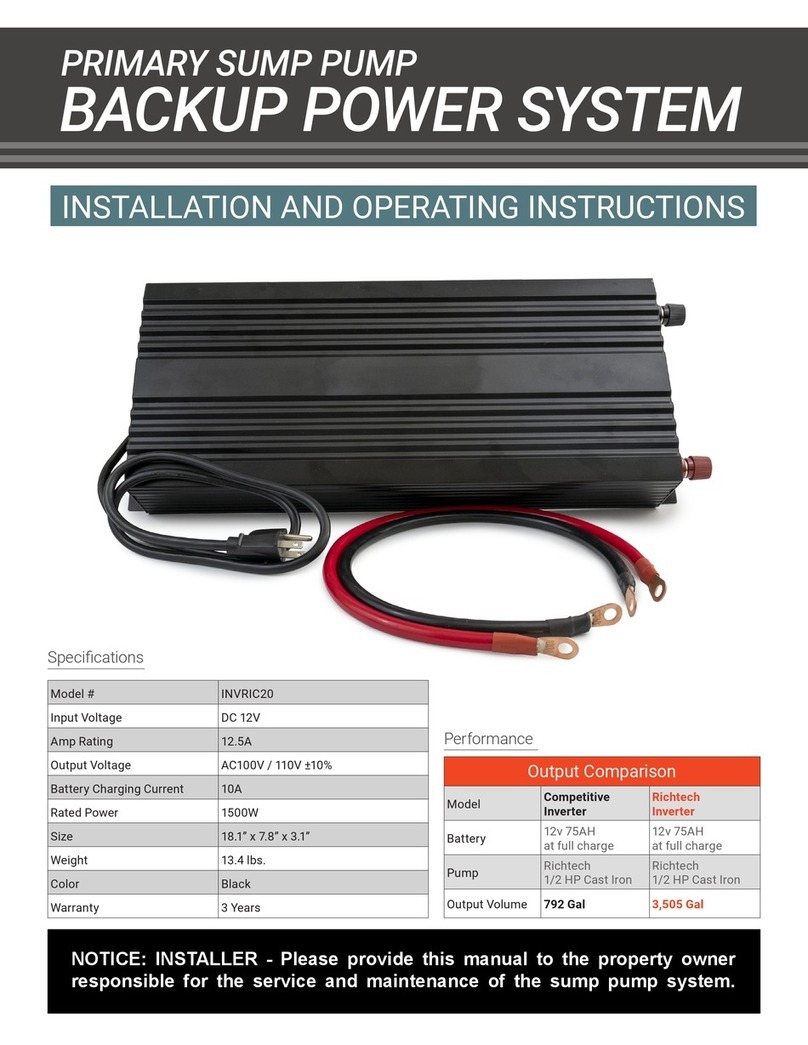
RICHTECH
RICHTECH INVRIC20 Installation and operating instructions
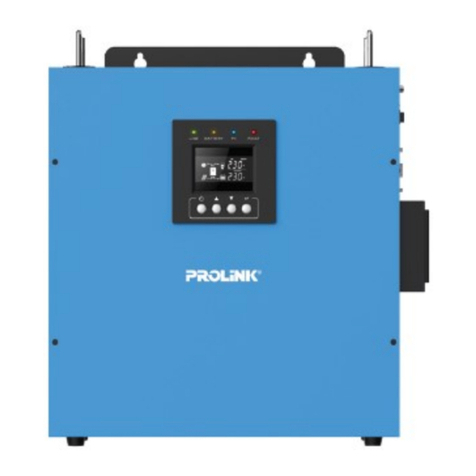
PROLiNK
PROLiNK IPS Series user manual
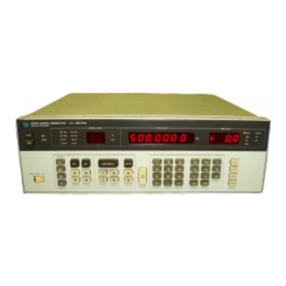
HP
HP 8656A Operating and service manual
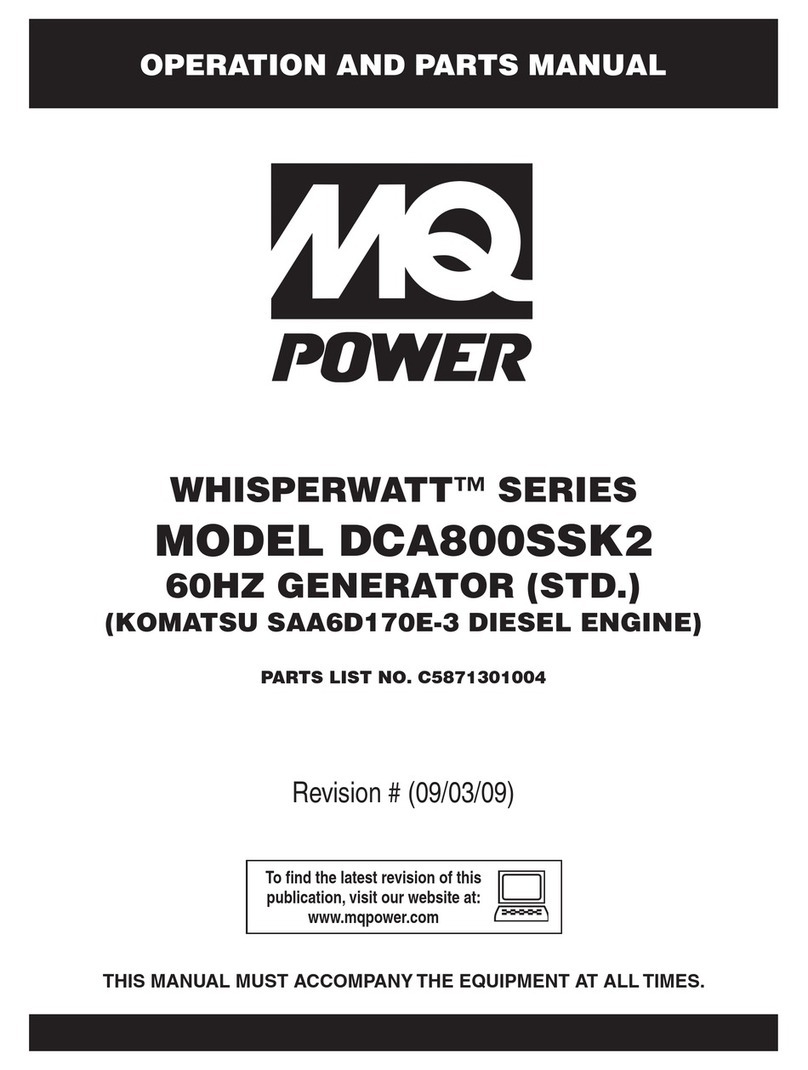
MULTIQUIP
MULTIQUIP WHISPERWATT DCA800SSK2 Operation and parts manual
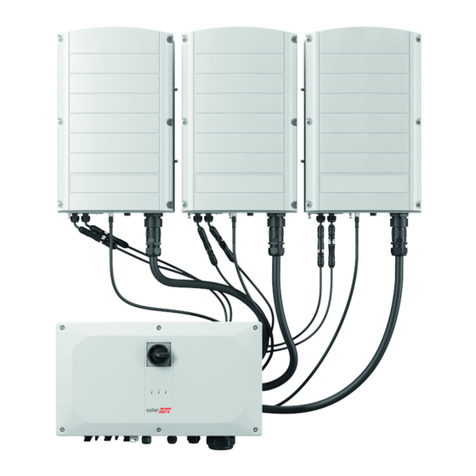
SolarEdge
SolarEdge SE K Series Quick installation guide
